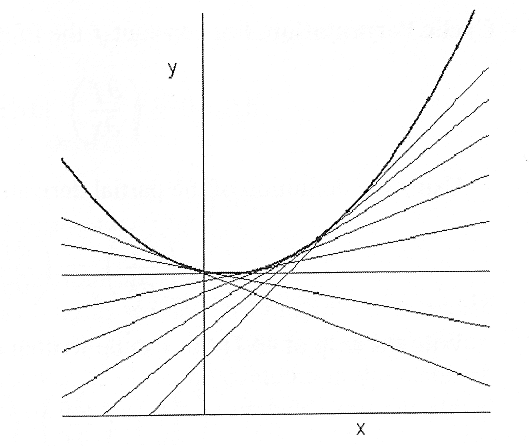Legendre transformations
Gibbs Law is this form of the first law: $$du=T\,ds-P\,dv.$$ So, we can naturally think of $u$ as being a function, $u(s,v)$, of entropy and volume. But the Pfaffian of such a function is... $$du=\frac{\del u}{\del s}ds +\frac{\del u}{\del v}\, dv.$$ If this is true, since $s$ and $v$ may be indepently varied, it must be the case that the coefficients of $ds$ in both of these equations are the same, as well as the coefficients of $dv$, which is to say: $$\left(\frac{\del u}{\del s}\right)_v \equiv T;\ \ \text{ and }\ \ \left(\frac{\del u}{\del v}\right)_s \equiv -P.$$
The enthalpy was defined as $h=u+Pv$ and so the differential of enthalpy is: $$\begineq dh&=du+P\,dv+v\,dP\\ &=(T\,ds-P\,dv)+P\,dv+v\,dP\\ &=T\,ds+v\,dP\\ \endeq$$ Apparently the enthalpy is naturally a function, $h(s,P)$, of entropy and pressure, where pressure is $-(\del u/\del v)_s$, whih is a partial derivative of $u$.
We've seen that $h$ is more useful than $u$ for constant pressure processes.
Legendre transformations
The relationship of $u=u(s,v)$ and $h=h(s,P)$ is an example of a more general problem: In what follows, $u\equiv\del f/\del x$ (not internal energy!), and $v\equiv \del f/\del y$ (not volume!).
- the independent variables of this new function are $u=\partial f/\partial x$ and $y$ instead of $x$ and $y$, and
- the function $g(u,y)$ is some composition of $f$, $x$, $y$, $u$, and $v$, and
- $g$ has the same units as $f$?
Given a function $f=f(x,y)$ of two independent variables $x$ and $y$: $$\begin{align} df = & \frac{\partial f}{\partial x} dx + \frac{\partial f}{\partial y} dy\\ \equiv & u\,dx + v\,dy.\end{align}$$
Is there some general recipe to come up with a function $g=g(u,y)$ where...
Yes! The recipe is surprisingly simple:
$$g = f - ux.$$
- You should verify that... $$dg = v\,dy - x\,du,$$ which shows that $g=g(u,y)$...
OK, let's do it: First think about the differential of $f(x,y)$: $$df=\frac{\partial f}{\partial x} dx +\frac{\partial f}{\partial y} dy.$$ We've defined $u\equiv \frac{\partial f}{\partial x}$ and $v\equiv\frac{\partial f}{\partial y}$, so this becomes: $$df=u\,dx+v\,dy$$ Since $g = f - ux,$ the differential $dg$ is $$dg=df-du\,x-u\,dx=df-x\,du-u\,dx. $$ Subbing in $df=u\,dx+v\,dy$: $$\begineq dg &=[\color{blue}{u\,dx}+v\,dy]-x\,du\color{blue}{-u\,dx}\\ &=\bf v\,dy-x\,du.\\ \endeq $$ which shows that $g=g(u,y)$.
The original definition of $v$ was $v=\frac{\partial f}{\partial y}$. But we see from this Pfaffian of $g(y,u)$ that it's also true that $v=\frac{\partial g}{\partial y}.$ Summarizing: $$v=\frac{\partial f}{\partial y} =\frac{\partial g}{\partial y}.$$
Looking at the Pfaffian, it must also be true that: $$x=-\frac{\partial g}{\partial u}.$$
Apparently, as the example of internal energy and enthalpy shows, $g=f+ux$ would also work as a Legendre transformation.
Legendre transformation of a function of 1 variable
In pictures!
Give this as an out-of-class exercise.
When $f$ is a function of just one variable, that is, $f=f(x)$, there is a nice visualization of the Legendre transformation.
The Pfaffian of a function of 1 variable, $f(x)$, is $df=(d f/d x)\,dx\equiv u\,dx$. The Legendre transformation is
$$g(x)=f -ux=f(x)-\left(\frac{df}{dx}\right)_{\text{at } x}x.$$

To find out graphically what the meaning of $g(x)$ is, you will carefully draw and label things on the accompanying figure:
- Pick some particular $x$ value, and label it as '$x$' on the $x$-axis.
- Draw a line up to meet the curve at $y=f(x)$.
- Draw a horizontal line to the $y$-axis, and mark this height as '$f(x)$' on the $y$-axis.
- Draw the tangent line to the function at $(x,f(x))$ that has slope $f'(x)$. Draw the line long enough to cross the $y$-axis.
- $u\cdot x = f'(x) x$ is the change in height ($\Delta y$) of the tangent line, as you go from $0$ to $x$ in the horizontal direction. Draw a vertical line segment of length $f'(x)x$ on the diagram in a place to make the connection visually with its meaning. Label the distance '$ux$' on your line segment.
- You have already marked $f(x)$ on the $y$-axis for the $x$ value you choose. Now find $g(x)=f(x)-ux$ visually, Mark and label that $y$ position as '$g(x)$' on the $y$-axis.
Now answer these questions or draw on the diagram as directed.
- How would you describe the relationship of $g(x)$ to $f(x)$?
- For $x=0$, what will $g(0)$ be?
- Choose a couple of other $x$-values and find $g(x)$ for each of these values. Use these to sketch out (in another color, but on the same figure) the function $g(x)$.
- Find algebraically the Legendre transformation $g(x)$ of the function
$f(x)=3x^2-x+5$.
- Plot with CoCalc or Desmos (or something else) the two functions $f(x)$ and $g(x)$ on the same graph. (In CoCalc you can plot( [f(x),g(x)], ...)). Print out and attach the plot: Label $f(x)$ and $g(x)$. Pick one $x$ value (not zero) and make the construction above to justify visually the value $g(x)$ for that $x$.
The Legendre transformations of internal energy
[OK, now we're back to $u\equiv$ internal energy and $v\equiv$ volume!]
Given $u(s,v)$, and its partial derivatives $T$ and $P$, we could find Legendre transformations which will be function of $s$ and $P$; $T$ and $v$; or $T$ and $P$:
| $du=T\,ds - P\,dv$ | $u(s,v)$ | $\partial u/\partial v = -P$ $\partial u/\partial s = T$ |
|
| $h=u+Pv$ | $dh = T\,ds + v\,dP$ | $h(s,P)$ | |
| $f = u - Ts$ | $df = -s\,dT - P\,dv$ | $f(T,v)$ | |
| $g = u -Ts+Pv$ | $dg=-s\,dT+v\,dP$ | $g(T,P)$ |
You can show any of these differentials by differentiating the definition of the function, and using $du=T\,ds-P\,dv$, then simplifying.
[Pro tip for googling: A Legendre "transformation" is different from a Legendre "transform".]